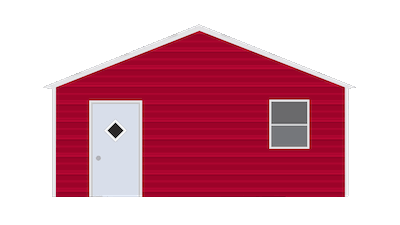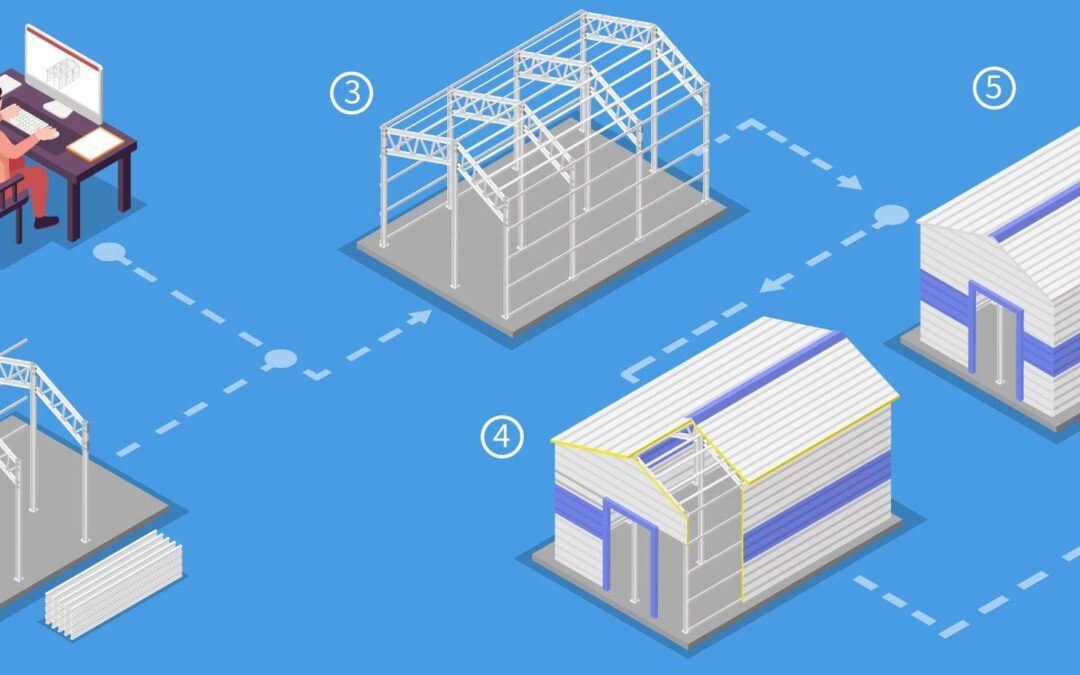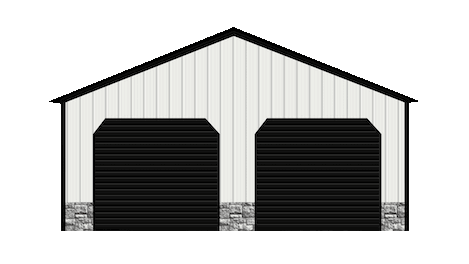The complete process of constructing a steel building involves careful planning, designing, and effective implementation according to the plan. The construction of metal buildings is a dynamic and various undertaking that combines innovation, accuracy, and efficiency that provide cost-effective construction solutions to residential and commercial projects.
This blog will emphasise the six main phases that guide the journey from the initial design concept to the completion of a fully functional metal structure. From the primary on-paper design and planning, where designers breathe life into blueprints, to the transformative site preparation and foundation installation, every step sets the stage for the ultimate assembly of the structural framework. This evolving structure then experiences growth in the enclosure and roofing phase, becoming weather-resistant and energy-efficient. Additionally, in the final phase of finishing and installation steel building truly comes to life.
Design and Planning
Planning includes deciding the size, setting a budget, building an engineered plan, and choosing building materials as well as a foundation. The journey starts with the intention behind the layout, purpose, and size of the metal building. A team of engineers creates a detailed blueprint according to various factors like the type of project, site condition, and so on to make sure it aligns with the desired results.
The journey starts with an idea of the function, design, and size of the metal building. To make your ideas a reality, most manufacturers employ engineers who work together to draft detailed blueprints that take local building codes, site conditions, and structural specifications into account. This is the first and most important stage in laying the groundwork for a successful construction project that is successful, making sure that the design matches with standards and functionality of the project.
Permission and Site Preparation
Municipalities and other authorities ask for complete application and engineered structural plans. Most municipalities also require a complete site plan for land improvements, which includes architecture documents and detailed engineering blueprints. The site plan shows building elements such as travelways, parking, drainage facilities, lightning, water lines, and so on. It takes a few days to complete this paperwork and a few weeks for approval by authorities, thus it is recommended to plan accordingly.
After design finalisation, the construction site moves on to complete preparation for the project. Clearing the land, grading for a level foundation, and addressing soil stabilisation requirements are crucial steps in developing a stable base for the steel building solution. It also includes arranging utilities such as water and sewer connections and laying the groundwork for the upcoming construction phases.
Foundation Installation
A well-designed and constructed foundation is vital for any building, many potential buyers proceed with foundation design and construction. The foundation installation acts as the strongest pillar in the construction of metal buildings. It provides stability and supports the entire steel construction. Components like columns, rafters, beams, and purlins are carefully positioned according to the engineered plans. Proper installation is essential for the structural integrity of the building, setting the stage for the next phases. Foundations for pre-engineered metal buildings are different and generally more complicated than those for conventional structures. Ensure to find an engineer locally to design these foundations and a reputable contractor to build them.
Assembly of Structural Framework
This phase represents the efficiency of metal building construction, as pre-engineered components are designed for quick and straightforward, minimising construction time compared to traditional methods of construction. After the foundation, the focus is to assemble metal components of the building’s structural framework. Components like columns, rafters, beams, and purlins are carefully set according to the plan and design of the engineer. It involves a complete process of lifting and placing components into position, then connecting them together according to the structure of the building. Connecting of these components is generally done through bolting and site welding sometimes.
Enclosure and Roofing
As the structural framework takes shape, the building enclosure and roofing are installed. Wall and roof panels, along with doors, windows, and insulation, are added carefully to complete the building cover. Buildings like Metal garages offer versatility in design, allowing for customization in aesthetics, energy efficiency, and overall functionality. The attention to detail during this phase ensures that the interior environment remains controlled and comfortable. The components of the steel structure mainly include a support system frame structure and roof structure system.
Finishing and System Installation
The final phase focuses on the interior of the metal building. The installation of interior walls, flooring, plumbing, electrical, and other fixtures satisfies the particular requirements of the building’s purpose. During this stage, the structural framework is transformed into a completely functional area that is prepared to handle all planned activities, including residential living, office work, manufacturing, and storage. Proper installation of everything such as plumbing and electrical appliances ensures that the building is ready and safe for activities to take place. The success of finishing and system installation depends on the excellent coordination of various professionals and attention to many elements like safety to meet the expectations of clients.
Ending Phase
We can conclude that the whole journey from the blueprint to the reality of steel building involves an exciting combination of these six phases. Each stage contributes to strengthening the steel building and making it better than a conventional building. In addition, it involves durability, functionality, and proper structure of steel building according to blueprint and engineers. Beyond the strong and resilient reputation that metal structures enjoy, the process itself is a symphony of careful planning, site transformation, and careful detailing. Steel building will continue to become one of the most popular choices in the construction industry. Various applications and understanding of the approach of the steel building construction process highlight the versatility and reliability of structure in the modern construction world.





 Home
Home Products
Products Styles
Styles Resources
Resources Service Area
Service Area About Us
About Us Contact Us
Contact Us Extras
Extras Search
Search Wishlist
Wishlist











